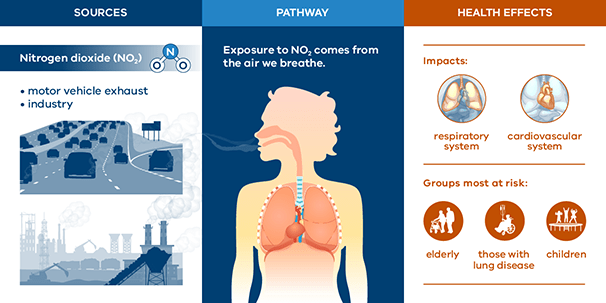Nitrogen dioxide (NO2) is a gas. Breathing it in can irritate your nose, throat and lungs. Nitrogen dioxide is a common air pollutant that can impact human health and the environment.
Nitrogen dioxide levels are usually low in Victoria. The main sources include:
- car and truck exhausts
- coal-fired power stations
- burning gas and diesel for heating and energy
- industry.
Nitrogen dioxide and the law
The general environmental duty applies to managing emissions containing nitrogen dioxide.
The Environment Reference Standard (ERS) sets the standard for nitrogen dioxide in the air.
Businesses must control nitrogen dioxide from their activities to:
- prevent harm
- comply with their legal duties
- meet community expectations.
The Environment Protection Regulations 2021(opens in a new window) set out obligations to manage nitrogen dioxide. This includes the requirement for some businesses to report their emissions to the National Pollutant Inventory.
In some cases, you must get our permission to conduct activities that release nitrogen dioxide into the atmosphere. Our permissions focus on activities that may have a significant impact on human health and the environment. Permissions have legal conditions that must be followed.
Activities involving nitrogen dioxide emissions may need the permission L01 – General discharges or emissions to the atmosphere.
Our role in nitrogen dioxide
We monitor air quality around Victoria. We have air monitoring equipment that measures air pollutants such as nitrogen dioxide. The data we collect supports our daily air quality forecasts.
We compare this data with nitrogen dioxide standards in the ERS. The ERS provides a benchmark to understand air quality and how to protect it – for example, when we assess permission applications for air emissions.
Learn more about how we monitor the quality of the environment.
Impact of nitrogen dioxide on your health
Breathing in high levels of nitrogen dioxide can affect your health. It can irritate your throat and lungs.
Some groups of people are more sensitive to nitrogen dioxide, such as:
- children younger than 14
- older people
- people with heart or lung conditions, including asthma
- pregnant people.
People in these groups are more likely to experience symptoms if they're exposed to nitrogen dioxide. Symptoms can include:
- coughing
- wheezing
- shortness of breath.
If you experience any of these symptoms, follow your treatment plan or seek medical advice.
If you're concerned about your health because of nitrogen dioxide, find out who to contact.
Updated


